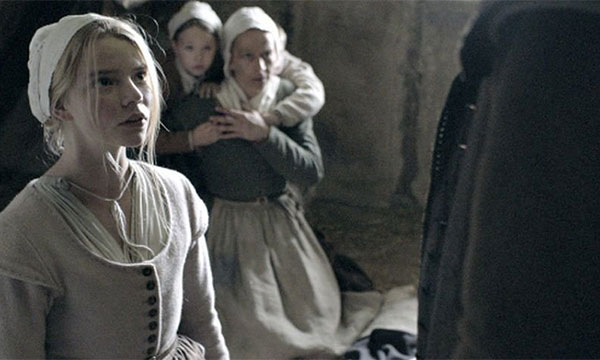The Witch (2015)

Set in New England in the early 1630s, six decades before the infamous Salem Witch trials, we find a family of devout Puritans vacating the tight-knit community they could not see eye to eye with, relocating to a small farm on the border of the untamed woods. Ralph Ineson (Kingsman, Guardians of the Galaxy) plays the patriarch, William, who finds it a struggle to raise crops in the area, forcing him to go out into the woods to hunt with son Caleb (Scrimshaw, Oranges and Sunshine) for sustenance until they can grow enough to feed themselves, and, hopefully, sell or barter the rest. Things begin to become ominous when eldest daughter Thomasin (Taylor-Joy, Vampire Academy) loses sight of their youngest, the newborn Samuel, and that’s just the start of many bizarre signs to come.
The Witch is the first feature film from a promising new talent, writer-director Robert Eggers, with the kind of critical buzz generated from its showings at various film festivals over the previous year to garner a wide release in 2016 from A24, despite it not being a very mainstream film in execution. Eggers, winner of the Best Director prize at 2015’s Sundance Film Festival, uses a variety of historical accounts during the “witch scare” era for the inspiration for his script, and infuses the dialogue with the vernacular of the times. This may likely make for some confusing moments for those who aren’t accustomed to Old English and thick accents, especially in a theater with a substandard sound system. However, it’s that sense of authenticity that makes The Witch refreshingly different than the norm, and though it is a period piece, the look of the movie makes good use of the budget by filming mostly in untamed locations (shot in the wilderness of Ontario, Canada) with a small collection of actors. It’s a film so contained to its locale, one could see this easily turning into an interesting stage play, should it turn into a cult hit. Unsurprisingly, Eggers’ background comes from live theater, utilizing his craft of costume and production design for the betterment of his film as a whole.
And it’s also sold from those actors, who also deliver some solid and engaging performances. Ineson’s uniquely rich voice and demeanor as William carries a good part of the film, and Anya Taylor-Joy is a real find as Thomasin. Both of them plays very well in their scenes with the matriarch, Katherine (Dickie, Prometheus), who is at wit’s end from the unhappiness caused not only by their having to uproot from their old home, but also from England outright, especially when they have to spend her days toiling with little to show for her labors, and her evenings praying for the safe return of her baby, and for the well-being of her other children, who also seem to be afflicted by something wicked in the air. It’s the seeds of paranoia, fear and fanatical religious beliefs that the country was built upon, and which is still something global society struggles with to this day. One can see the quickness to turn on one another as a result of that overwhelming superstition, of monsters among them, even toward those they’ve known and loved their entire lives.
The Witch is certainly unnerving, and refreshingly devoid of the jump-scare gimmicks that pollute most modern-day horror flicks. It’s sparsely scored through choral pieces by Mark Korven (Cube) in very effective ways to set the proper ominous atmosphere, especially when combined with the washed-out, increasingly bleak cinematography from Jarin Blaschke (I Believe in Unicorns). Some viewers may draw parallels to such filmmakers as Stanley Kubrick in the deliberate way Eggers spins his tale (especially The Shining), perhaps with a little visual influence of Ingmar Bergman in the mix. Patience is a must, as the deliberate pacing may make those who are anxious to get to the good stuff give up on the film early on. For those who keep focus and let the film play out in its own time, it will yield rewards in the riveting second half that will have you wondering whether the close-knit family will turn their proverbial daggers on each other before whatever malevolence that exists in the forest can do it to them first, if it truly exists at all.
I should take the time here to not oversell the horrors of The Witch, as this is definitely not a film built on pleasing the typical horror-movie crowds who are looking for formula jolts delivered at predictable intervals — the crowd that would rather see another Insidious or Sinister sequel than the thematically rich and character-driven terror found in original properties like It Follows or The Babadook. This is the very definition of a slow-burn fright flick, spending nearly an entire hour building a state of unease just to set up for the freakiness that emerges in the film’s riveting half hour. Most of the horror is of the psychological variety, as we’re more afraid of the things we don’t see than those that we do. It’s a real nail-biter when things get tense as we’re ready to avert our eyes from seeing a family we’ve come to be rooted in about to be torn asunder from forces they cannot see or understand fully until it’s too late. Though some will shift restlessly from the deliberate build-up, The Witch eventually emerges an eerie, unsettling shocker that sticks with you like a bewitching spell that can’t be shaken.
Qwipster’s rating: A
MPAA Rated: R for disturbing violent content and graphic nudity
Running Time: 92 min.
Cast: Anya Taylor-Joy, Ralph Ineson, Kate Dickie, Harvey Scrimshaw, Ellie Grainger, Lucas Dawson
Small role: Sarah Stephens
Director: Robert Eggers
Screenplay: Robert Eggers
